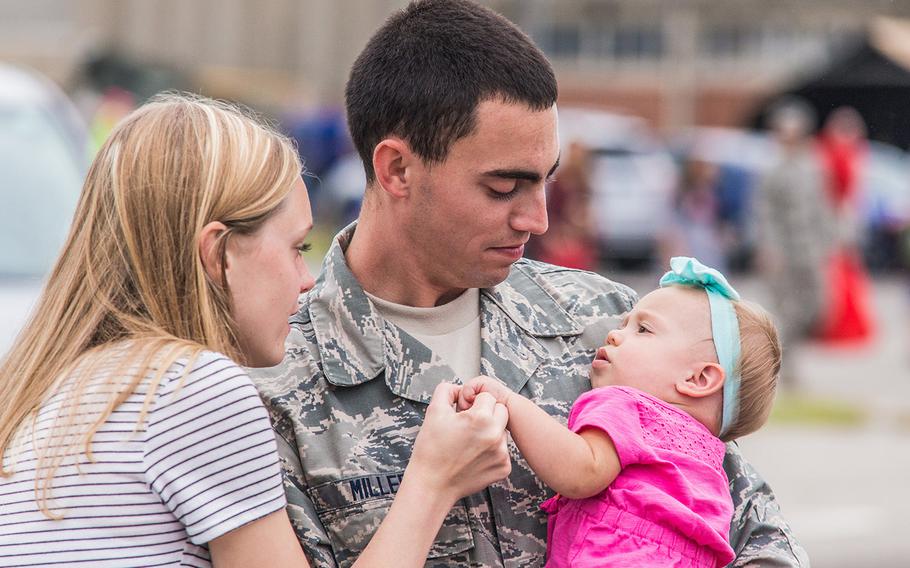
Airmen with the 139th Airlift Wing, Missouri Air National Guard, bring their families to participate in a Family Fun Day, at Rosecrans Air National Guard Base, St. Joseph, Mo., July 6, 2017. (Patrick Evenson/U.S. Air National Guard)
For years, issues of pay and benefits have been high on the list of concerns that servicmembers and their families have about their military lifestyle.
But the toll of 16 years of continued wars and the separation of families with demands has finally nudged its wayto the top, according to this year’s Blue Star Families Military Lifestyle survey.
For the first time since 2012, nearly half of the survey respondents, 46 percent, said concern about time away from family was their top concern.
“The majority of military families feel that the current operational tempos exerts an unacceptable level of stress, making a healthy work-life balance difficult,” said the survey’s executive summary. “Quality of life issues, including time away from family, military family stability and the impact of military service on children are top concerns this year, along with lasting concerns regarding pay, benefits and spouse employment.”
The eighth annual survey, conducted in April and May, involved more than 7,800 respondents including servicembembers, spouses and veterans and, according to Blue Star Families, is the largest and most comprehensive survey of its kind.
According to the survey, a third of families spent 25 percent of the last 16 years apart from the servicemember, while 40 percent of the respondents said that in the last 18 months, they had experienced more than six months apart.
That finding leads to another concern, the survey found: the impact on children. In another first for the survey, the impact of deployments and their children’s education made it to the top five concerns for servicemembers and spouses. The concerns are not new, but their placement on both of the top five lists makes this year’s findings unique.
Military families move a lot, meaning their children must adjust frequently to new schools while also coping with frequent absences as their parent deploys. More than half the respondents said the Department of Defense was not giving adequate support to help kids cope with the challenges that military life creates. Two thirds said that finding reliable child care is a consistent problem.
Citing concerns about the impacts on their family, 22% of servicemember respondents said they planned to leave the military in the next two years. About 30 percent said concerns about the impact on family was driving the decision, while 25 percent cited not enough time with family.
While most servicemembers said they would recommend service to other people, 60 percent said they would not recommend it to their own children.
Also not new to the list: concerns about pay and spouse employment, which continues to be a challenge for military families, because of the frequent moves. According to the survey, military spouse unemployment rose from 21 percent last year to 28 percent in 2017. While some choose not to work, fewer than 48 percent of military spouse respondents are employed, compared with 67 percent of civilian households on dual income. And just over half of employed military spouses made less than $20,000 last year while 39 percent made under $10,000, the survey found.
This was the first time the survey asked spouses how much they earned, said Cristin Orr Shiffer, senior adviser for research and policy for Blue Star Families and a lead author on the survey that was conducted with the Institute of Veterans and Military Families at Syracuse University in New York.
“The earnings is a shockingly low percentage,” Orr said. “Pay is a salary for families, not just for servicemembers.”
Because there is a much smaller percent of dual incomes in the military, military salaries should be calculated differently than salaries in the civilian world, she said. “It should be an adjusted metric.”
Meanwhile, findings in the survey indicated that traditional gender roles for families are still very prevalent in the military lifestyle, with women indicating more concerns over child care impacting work issues than their male counterparts.
For example, 67 percent of female servicemembers reported they could not find child care that works, compared to only 33 percent of male servicemembers and male military spouses who were “far less likely to indicate child care challenges as a factor in employment or education decisions, with 40 of male military spouses versus 17 percent of female military spouses reporting their employment or education decisions had not been impacted by child-care challenges,” the report found.
Meanwhile 49 percent of male military spouses reported working full time compared with 27 percent for female spouses, and 50 percent of female spouses reporting family obligations were a top career obstacle, compared with 30 percent of male respondents.
“Gender roles are still very deeply ingrained in the military – both for servicemembers and their spouses,” Shiffer said. “Male servicembembers and spouses tend to be much less likely to be impacted by those challenges.”
While the rates for anxiety or depression among servicemembers were on par with the general population, the survey found that military spouses had a 50 percent higher rate of depression. It found that 24 percent of military spouses were diagnosed with depression over the course of their military association, compared with just half that rate in the lifetime of civilian spouses.
Despite all the challenges, however, the survey found that 72 percent of servicemembers and 77 percent of spouses are satisfied with military life. Among veterans, 93 percent of women and 95 percent of men felt the service had a positive impact on their lives.
cahn.dianna@stripes.com Twitter: @DiannaCahn